
Fort Sumter is a Third
System masonry coastal
fortification located in
Charleston Harbour. The fort is best known
as the site upon which the shots initiating the American Civil War were fired, at
the Battle of Fort Sumter.
Construction: Named after General Thomas Sumter, Revolutionary
War hero, Fort Sumter was
built following the War of 1812, as one of a series of
fortifications on the southern U.S. coast. Construction began in 1827, and the
structure was still unfinished in 1861, when the Civil War began. Seventy
thousand tons of granite were imported from New England to build up a sand
bar in the entrance to Charleston
Harbour, which the site dominates. The fort was a
five-sided brick structure, 170 to 190 feet long, with walls five feet thick,
standing 50 feet over the low tide mark. It was designed to house 650 men and
135 guns in three tiers of gun emplacements, although it was never filled near
its full capacity.

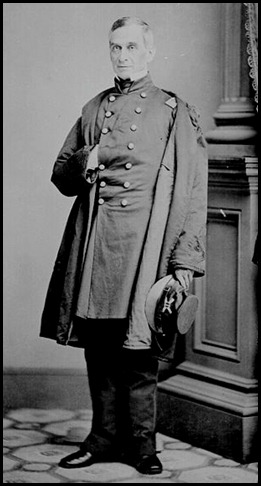
Beauregard
had been one of Anderson’s artillery students
at West Point in 1837 and, while determined to evict the Federal troops from
Fort Sumter, did not welcome the prospect of firing on his old friend and former
instructor.
Civil War: On the 26th of December 1860, six days
after South Carolina declared its secession, U.S. Army Major Robert
Anderson abandoned the indefensible Fort
Moultrie and secretly relocated companies E
and H (127 men, 13 of them musicians) of the 1st U.S. Artillery to Fort Sumter on his own initiative,
without orders from Washington. He thought that providing a stronger defense would delay an
attack by South Carolina militia. The fort was not yet complete at the time and
fewer than half of the cannons that
should have been available were in place, due to military downsizing by
President James Buchanan. Over the next few months repeated
calls for evacuation of Fort Sumter from the government of South Carolina and then from Confederate
Brigadier General P.G.T. Beauregard were ignored. Union attempts to
resupply and reinforce the garrison were repulsed on the 9th of January 1861
when the first shots of the war, fired by cadets from The Citadel, The Military
College of South Carolina, prevented the steamer Star of
the West,
hired to transport troops and supplies to Fort Sumter, from completing the task.
After realising that Anderson's command would run out of food by the 15th of
April 1861, President Lincoln ordered a fleet of ships, under the
command of Gustavus V. Fox, to attempt entry into Charleston
Harbour and support Fort Sumter. The ships assigned were the steam sloop-of-war
USS Pawnee, steam
sloop-of-war USS Powhatan,
transporting motorised launches and about 300 sailors (secretly removed from the
Charleston fleet to join in the forced reinforcement of Fort
Pickens, Pensacola, Fla.), armed screw
steamer USS Pocahontas, Revenue Cutter USRC Harriet Lane,
steamer Baltic transporting about 200 troops, composed of
companies C and D of the 2nd U.S. Artillery, and three hired tug boats with
added protection against small arms fire to be used to tow troop and supply
barges directly to Fort Sumter. By the 6th of April 1861 the first ships began to set sail for
their rendezvous off the Charleston Bar.
The first to arrive was the Harriet Lane,
before midnight of the 11th of April 1861. The fleet arrived too late to defend
the fort but were on hand to evacuate the Union troops to New York after their
surrender.
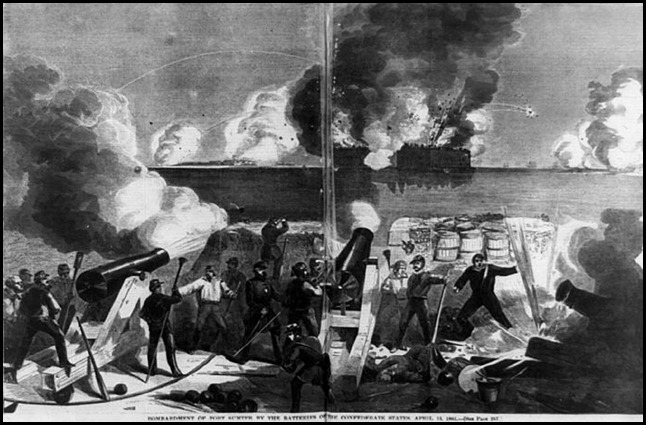

First Battle of Fort
Sumter: On Thursday the 11th
of April 1861, Beauregard sent three aides, Colonel James Chesnut
Jr., Captain Stephen D. Lee, and Lieutenant
A. R. Chisolm to demand the surrender of the fort. Anderson declined, and the
aides returned to report to Beauregard. After Beauregard had consulted the
Secretary of War, Leroy Walker, he sent the
aides back to the fort and authorised Chesnut to decide whether the fort should
be taken by force. The aides waited for hours while Anderson considered his
alternatives and played for time. At about 3 a.m., when Anderson finally
announced his conditions, Colonel Chesnut, after conferring with the other
aides, decided that they were "manifestly futile and not within the scope of the
instructions verbally given to us". The aides then left the fort and proceeded
to the nearby Fort Johnson. There, Chesnut ordered the fort to open fire on Fort
Sumter.
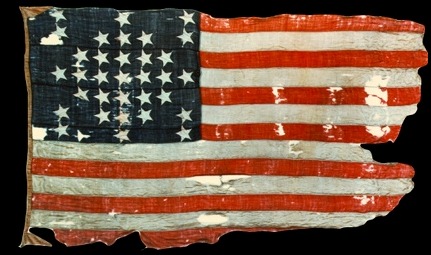
On Friday th 12th of April
1861, at 4:30 a.m., Confederate batteries opened fire, firing for thirty four
straight hours, on the fort. Edmund Ruffin,
noted Virginian agronomist and secessionist, claimed that he fired the first
shot on Fort Sumter. His story has been widely believed, but Lieutenant Henry S.
Farley, commanding a battery of two mortars
on James Island fired the first shot at 4:30
A.M. (Detzer 2001, pp. 269–71). No attempt
was made to return the fire for more than two hours. The fort's supply of
ammunition was not suited for the task, also there were no fuses for their
explosive shells, only solid balls could be used against the Rebel batteries. At
about 7:00 A.M., Captain Abner Doubleday ,
the fort's second in command, was given the honour of firing the first shot in
defense of the fort. The shot was ineffective, in part because Major Anderson
did not use the guns mounted on the highest tier, the barbette tier, where the
gun detachments would be more exposed to Confederate fire. The firing continued
all day, the Union fired slowly to conserve ammunition. At night the fire from
the fort stopped, but the Confederates still lobbed an occasional shell in
Sumter. On Saturday the 13th of April, the fort was surrendered and evacuated.
During the attack, the Union colours fell. Lt.Norman J. Hall risked life and limb to put them back up, burning off
his eyebrows permanently. No Union soldiers died in the actual battle though a
Confederate soldier bled to death having been wounded by a misfiring cannon. One
Union soldier died and another was mortally wounded during the 47th shot of a
100 shot salute, allowed by the Confederacy. Afterwords the salute was shortened
to 50 shots. Accounts, such as in the famous diary of Mary Chesnut, describe Charleston residents along what is now known
as The Battery, sitting on balconies and
drinking salutes to the start of the hostilities. The Fort Sumter
Flag became a popular patriotic symbol after
Major Anderson returned North with it. The flag is still displayed in the fort's
museum. A supply ship Star of the West took all the Union soldiers to New
York City. There they were welcomed and honoured with a parade on
Broadway.
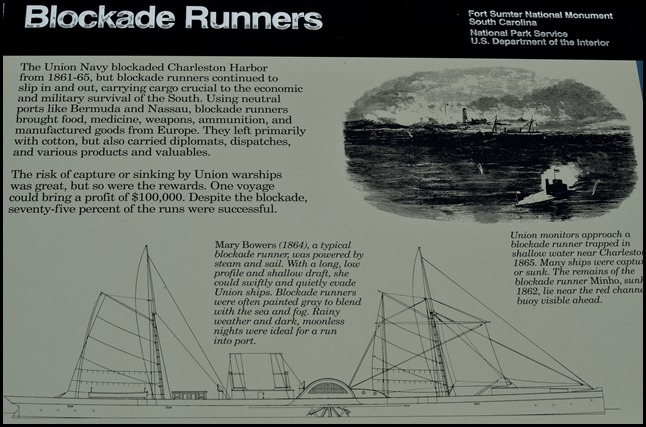
Union Siege of Fort Sumter: Union efforts to retake
Charleston Harbour began on the 7th of April 1863, when Rear Admiral Samuel
Francis Du Pont, commander of the South Atlantic Blockading
Squadron, led the ironclad frigate New
Ironsides, the tower ironclad Keokuk, and the monitors
Weehawken, Pasaic, Montauk, Patapsco, Nantucket, Catskill and
Nahant in an attack against the harbour’s defenses. The
attack was unsuccessful, the New
Ironsides never effectively
engaged, and the ironclads fired only 154 rounds, while receiving 2,209 from the
Confederate defenders (Wise 1994, p. 30). Due to damage received in the attack, the
Keokuk sank the next day, 1,400 yards off the southern tip
of Morris Island. Over the next month, working at night to avoid the
attention of the Federal squadron, the Confederates salvaged the Keokuk’s two XI-inch Dahlgren guns (on of them
was
placed in Fort Sumter).
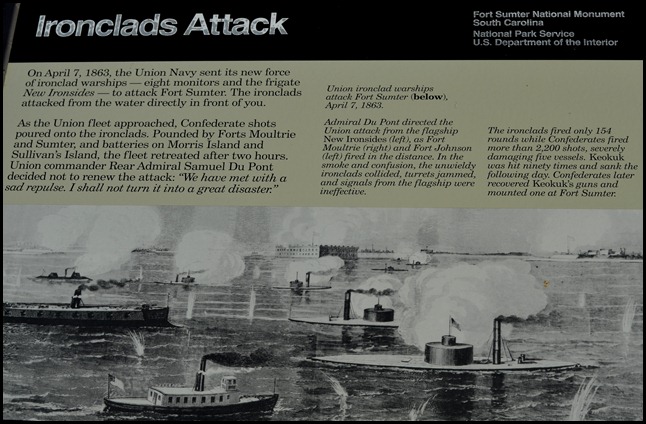
The Confederates, in the meantime,
were strengthening Fort Sumter. A workforce of just under 500 slaves, under the
supervision of Confederate army engineers, were filling casemates with sand,
protecting the gorge wall with sandbags and building new traverse,
blindages and bombproofs. Some of Fort Sumter’s artillery had been removed, but
40 pieces still were mounted. Fort Sumter’s heaviest guns were mounted on the
barbette, the fort’s highest level, where they had wide angles of fire and could
fire down on approaching ships. The barbette was also more exposed to enemy
gunfire than the casemates in the two lower
levels of the fort.
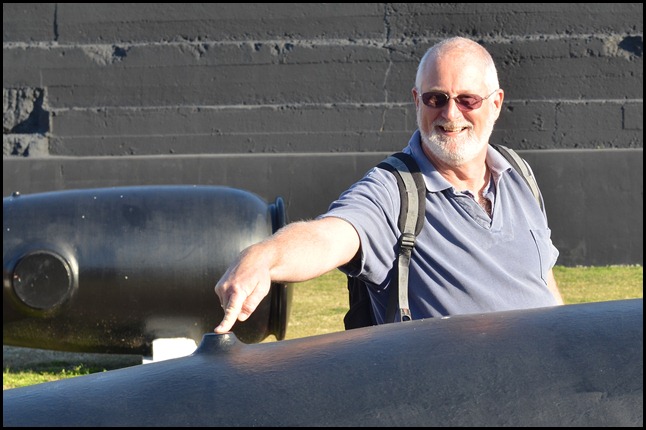
After the devastating bombardment,
both General Quincy A. Gillmore and Rear
Admiral John A. Dahlgren, now commanding
the South Atlantic Blockading Squadron, determined to
launch a boat assault on Fort Sumter for the night of the 8th-9th of September
1863. Cooperation between the Army and Navy was poor, Dahlgren refusing to place
his sailors and marines under the command of
an army officer. So two flotillas set out towards Fort Sumter that night. The
army flotilla was detained off Morris Island
by the low tide. By the time they could proceed, the navy assault had already
been defeated and the army flotilla returned to shore.
The Navy’s assault involved 400 sailors and marines in 25 boats. The
operation was a fiasco from beginning to end – no comment. Poor reconnaissance,
planning and communication all characterised the operation. Commander Thomas H.
Stevens, commanding the monitor
Patapsco, was placed in charge of the
assault. When Commander Stevens protested that he “knew nothing of (the
assault’s) organisation “ and “made some remonstrances on this grounds and
others.” Dahlgren replied “There is nothing but a corporal’s guard (about 6 - 10
men) in the fort, and all we have to do is go and take possession.” This underestimation of the Confederate forces on
Dahlgren’s part may explain why he was hostile to a joint operation wishing to
reserve the credit for the victory to the Navy. Less than half of the boats
landed. Most of the boats that did land landed on the right flank or right gorge
angle, rather than on the gorge where there was a passable breach. The Union sailors and marines who did land could not
scale the wall. The Confederates fired upon the landing party and as well as
throwing hand grenades and masonry. The men in the boats that had not landed
fired muskets and revolvers blindly at the fort, endangering the landing party
more than the garrison. The landing party took shelter in shell holes in the
wall of the fort. In response to a signal rocket fired by the garrison, Fort
Johnson and the Confederate warship Chicora
opened fire upon the boats and landing party. The boats that could withdraw
withdrew and the landing party surrendered. The Union casualties were 8 killed,
19 wounded and 105 captured (including 15 of the wounded). The Confederates did
not suffer any casualties in the assault.
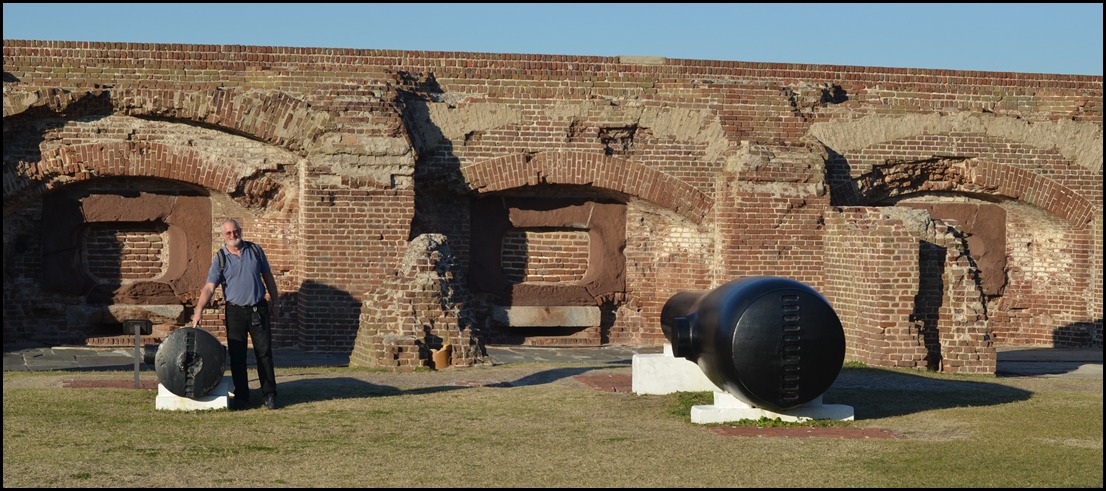
After the unsuccessful boat assault,
the bombardment recommenced and proceeded with varying degree of intensity,
doing more damage to Fort Sumter until the end of the war. The garrison continued to suffer casualties. The
Confederates continued to salvage guns and other material from the ruins and
harassed the Union batteries on Morris Island with sharpshooters.
The Confederates mounted four 10-inch columbiads, one 8-inch columbiad rifled, and two rifled
42-pounders, in the left face, bottom tier casemates. The last Confederate
Commander, Major Thomas A. Huguenin, a graduate from The Citadel, The Military
College of South Carolina, never surrendered
Fort Sumter, but General William T. Sherman’s advance through South Carolina finally forced the
Confederates to evacuate Charleston on the 17th of February 1865 and abandon
Fort Sumter. The Federal government formally took possession of Fort Sumter on
the 22nd of February 1865 with a flag raising ceremony. One Union soldier was
killed and another Union soldier was mortally wounded during the surrender
ceremony. Fifty two Confederate soldiers were killed there during the remainder
of the war. While a number of slaves were killed while working at the fort, the
exact number is unknown.
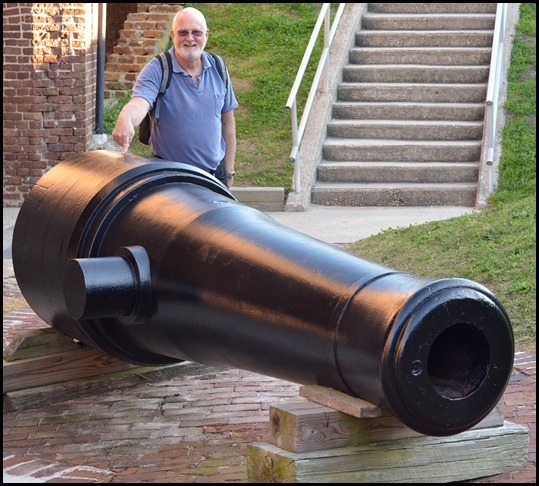
After the war:
When the Civil War ended, Fort Sumter
was in ruins. The U.S. Army worked to restore it as a useful military
installation. The damaged walls were re-leveled to a lower height and partially
rebuilt. The third tier of gun emplacements was removed. Eleven of the original
first-tier gun rooms were restored with 100-pounder Parrott rifles. From 1876 to 1897,
Fort Sumter was used only as an unmanned lighthouse station. The start of the
Spanish-American War prompted renewed
interest in its military use and reconstruction commenced on the facilities that
had further eroded over time. A new massive concrete blockhouse-style
installation was built in 1898 inside the original walls. Named "Battery Huger"
in honor of Revolutionary War General Isaac Huger, it never saw combat.

Fort Sumter National
Monument: Encompasses three sites
in Charleston: the original Fort Sumter, the
Fort Sumter Visitor Education Center and the Fort
Moultrie on Sullivan's Island. Access to Fort Sumter itself
is by a 30 minute ferry ride from the Fort Sumter Visitor Education Center or
Patriots Point. The Visitor Education Center's museum features
exhibits about the disagreements between the North and South that led to the
incidents at Fort Sumter. The museum at Fort Sumter focuses on the activities at
the fort, including its construction and role during the Civil War. The 12th of
April 2011 marked the 150th Anniversary of the start
of the Civil War. There was a commemoration of the events by thousands of Civil
War reenactors with encampments in the area. A United States stamp of Fort
Sumter, and first day cover, was issued that day.
ALL IN ALL A VERY POPULAR TOURIST
ATTRACTION
|

